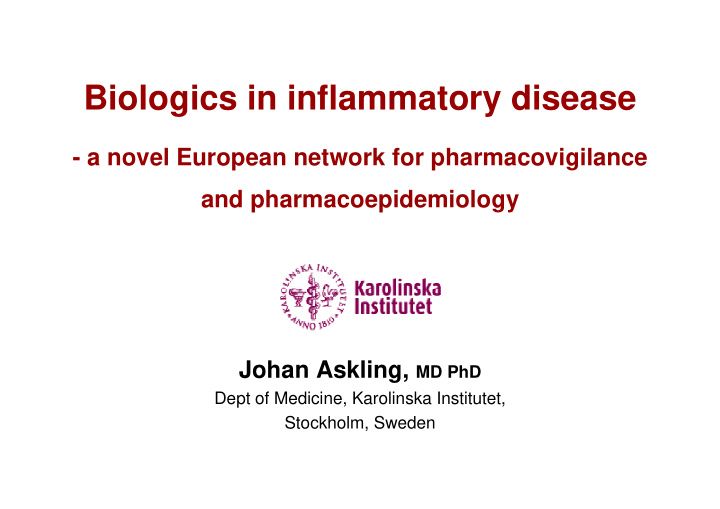



Biologics in inflammatory disease - a novel European network for pharmacovigilance and pharmacoepidemiology Johan Askling, MD PhD Dept of Medicine, Karolinska Institutet, Stockholm, Sweden
Biologics in inflammatory diseases As a rheumatologist, you may choose between… Anti TNF-alpha Adalimumab Etanercept Infliximab Golimumab Anti IL-1 Kineret Anti B-cell (CD20) Rituximab Anti T-cell (CTLA4) Abatacept Anti IL-6 Tociluzumab …and one out of four of your patients is treated
Drug safety in chronic disease Time-course of the chronic disease Disease activity Co-morbidity Destruction, loss of function
Safety of biologics: challenges Co-morbidity as an indirect treatment outcome Destruction, loss of function Therapy Disease activity Co-morbidity
Safety of biologics: challenges Co-morbidity as a direct treatment outcome Destruction, loss of function Therapy Disease activity Co-morbidity
Safety of biologics: challenges Co-morbidity as a safety endpoint Destruction, loss of function Therapy Disease activity Co-morbidity
Safety of biologics: challenges Attribution of an observed risk risk Risk directly related to treatment Risk due to disease (control) Baseline risk in humans
European Biologics Registers
European Biologics Registers name started coordination type inclusion controls current size follow-up British Society for 2001 arc Epidemiology epidemiologic new control group >14,000 baseline, Rheumatology Unit Manchester cohort study prescription of collected at controls: > 3,6,12,18,24,30, Biologics Register biologic; 4,000 defined sites 3,000 36,48,60 months (BSRBR) per drug German Biologics 2001 Epidemiology Unit, epidemiologic new internal >3,500 baseline, Register RABBIT German cohort study prescription of control group: controls: 3,6,12,18,24,30, Rheumatism biologic; 1,000 DMARD 1,800 36,48,60,72,84,96 Research Centre per drug failures , 108,120 months Swedish Biologics 1999 Karolinska Institute, routine new national 18,000 baseline, Register ARTIS Stockholm registration prescription of register data treatments 3,6,12,18,24 biologic months etc. Spanish 2000 Research Unit of routine new EMECAR >8,000 registration at BIOBADASER Spanish Society of registration prescription of cohort patients inception of register Rheumatology biologic adverse event Danish 2000 Hvidovre Hospital routine new > 3,500 RA regular visits as Rheumatologic registration in prescriptions long as patients is database DANBIO 26 seen in rheumatologic department departments Norwegian DMARD 2000 Diakonhjemmet routine treatment start DMARDs > 2000 Baseline, 3, 6, 12, register NOR- Hospital, Oslo registration of all with DMARD 24, 36, etc. DMARD DMARDs and or biologic months biologics agent Dutch Rheumatoid 2003 Radboud University epidemiologic start of early RA >1,000 Baseline, Arthritis Monitoring Nijmegen Medical cohort study treatment with cohort 3,6,9,12,18,24,30, Register DREAM Centre biologic agent 36 etc. months Swiss Clinical 1996 University of routine start of DMARD >2,000 annually Quality Geneva registration treatment with patients patients Management biologic agent Database
European Biologics Registers Specific features 1.Initiated by the profession 2.Disease registers, not drug-specific
Drug- or Disease- registers? In reality, and as seen from a disease-register Patient 1 pneumonia Patient 2 cancer Patient 3 Patient 4 MI Patient 5 = infliximab = etanercept = rituximab
European Biologics Registers Specific features 1.Initiated by the profession 2.Disease registers, not drug-specific 3.From treatment start, and onwards 4.Use of comparators
“project-based” biologics registers Anti-TNF starters comparator cohort
“project-based” biologics registers Anti-TNF starters external comparator RA cohort (EMECAR)
“integrated” biologics registers Swedish Rheumatology Registers Baseline data Follow-up data
“integrated” biologics registers Other National Swedish Registers National health-related registers Demographics registers � Hospital Discharge Register � Population Register � Non-GP Outpatients Register � Emigrations Register � Prescription Register � Generation Register � Cancer Register � Census Surveys Data � Cause of Death Register � Medical Birth Register � TB register
“integrated” biologics registers Biologics exposure Non-exposed subjects with the disease General population comparator
European Biologics Registers Specific features 1.Initiated by the profession 2.Disease registers, not drug-specific 3.From treatment start, and onwards 4.Use of comparators 5.Supported by joint grants from all companies 6.Standardised reporting of data for PSURs 7.Inter-register collaboration
Stake-holders in disease registers Patients Health authorities Clinicial care Company Z Register Medical academia Regulators Company Y Company X
European Biologics Registers Specific features 1.Initiated by the profession 2.Disease registers, not drug-specific 3.Designed for ”indefinite” follow-up 4.Use of comparators 5.Supported by joint grants from all companies 6.Standardised reporting of data for PSURs 7.Inter-register collaboration
Conclusions
Further reading… European Biologics Registers – methodology, results, and perspectives . Zink A, Askling J, Dixon W, Klareskog L, Silman A, Symmons D. Annals of Rheumatic Diseases, Epub 2008
Recommend
More recommend